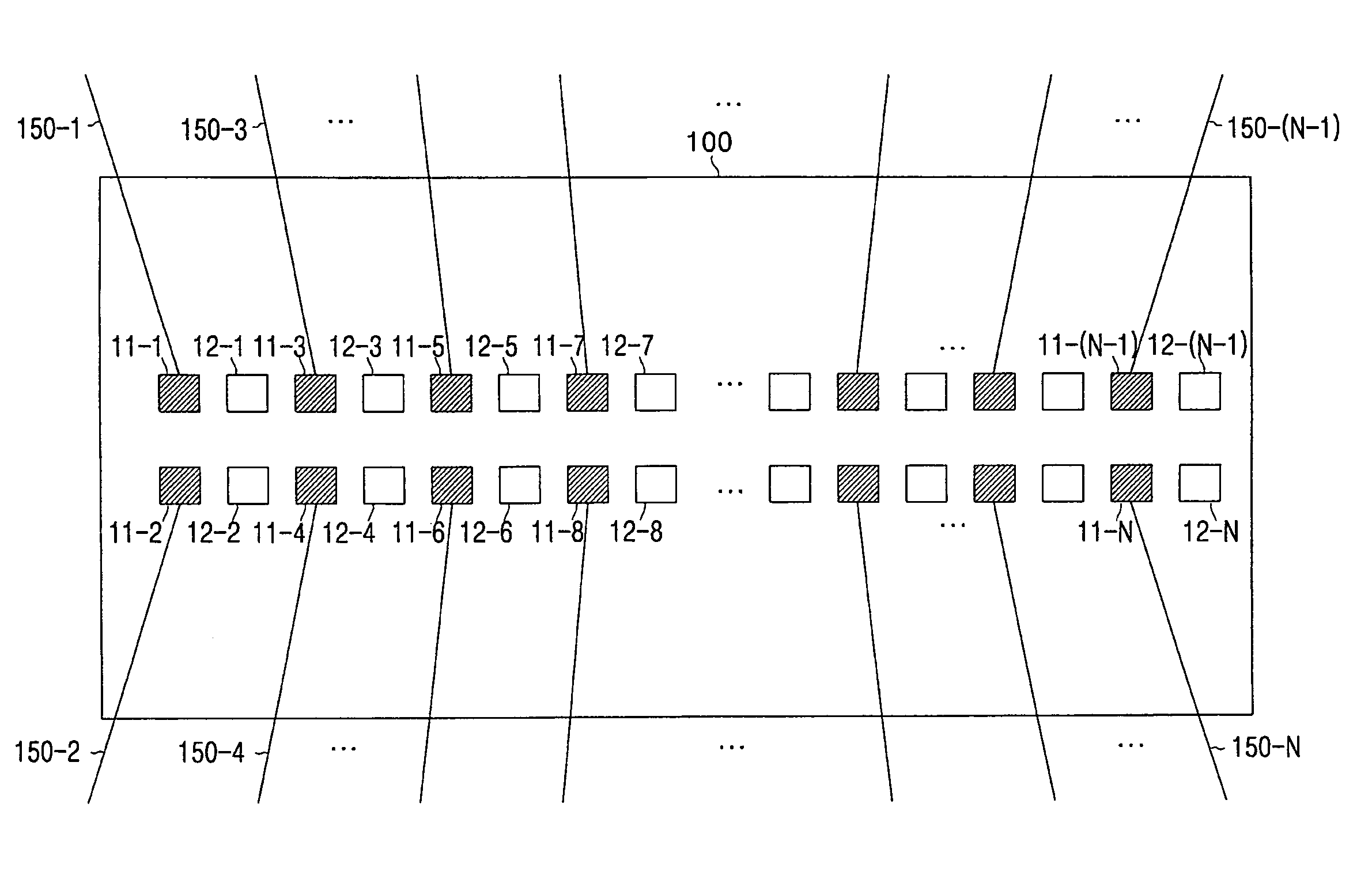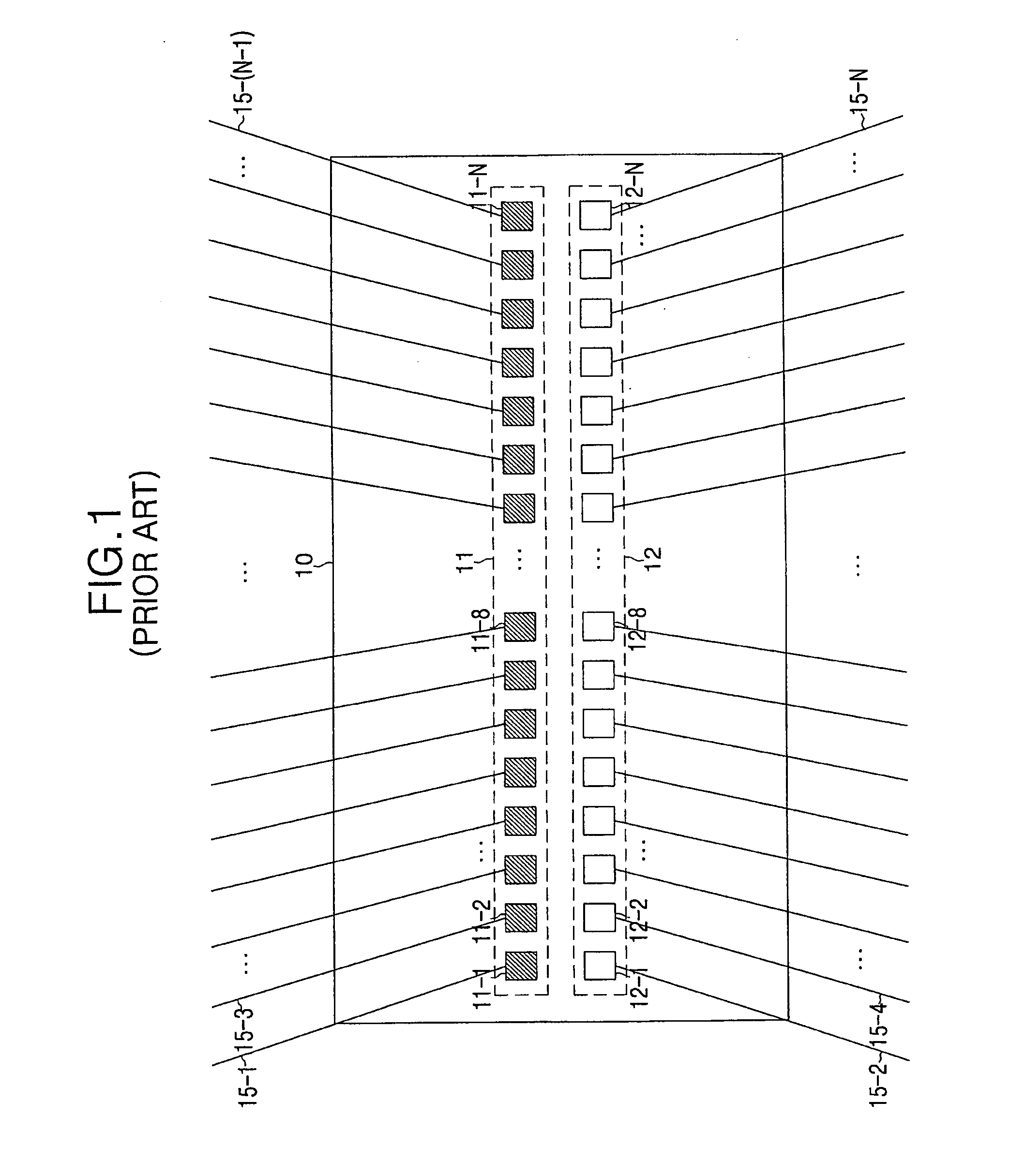Semiconductor memory device and test method thereof
a memory device and semiconductor technology, applied in semiconductor/solid-state device testing/measurement, solid-state devices, instruments, etc., can solve the problems of difficult to reduce the chip size and fabricate a package, difficult to fabricate a package including 500 ball-outs or more, and difficult to perform pad probing
- Summary
- Abstract
- Description
- Claims
- Application Information
AI Technical Summary
Benefits of technology
Problems solved by technology
Method used
Image
Examples
first embodiment
[0078]It is possible to solve this problem by enlarging only the pad pitch of the center pad structure shown in FIG. 2, because the plurality of probes 150-1 to 150-N of the probe card can incorrectly contact the plurality of first and second channel pads 20-1 to 20-N and 30-1 to 30-N due to a limitation of the pad size in the wafer test apparatus of the
[0079]That is, in order to overcome the problem, a plurality of pads are disposed to correspond to one channel in two rows to increase a pad size to fabricate the probe card having a large interval between the probes 150-1 to 150-N, thereby stably performing the test. Then, the test can be stably performed through the other of the first channel pads and the second channel pads using the probe card having the probes 150-1 to 150-N having the same interval.
[0080]In addition, in contrast to the test method of the first embodiment for testing a wafer having a large pad pitch shown in FIG. 2, when the wafer test is completed through one o...
third embodiment
[0101]The test method of the third embodiment is a method of grouping some pads having the same function as the plurality of channels to operate all of the channels using a small number of pads during a wafer test operation of the semiconductor memory device.
[0102]For example, when a plurality of data input / output signal pads, a plurality of address signal pads, and some command signal pads are all connected to the plurality of channels in the semiconductor memory device during a test mode operation, and some control signal pads, such as a chip selection signal (CS), are used for the plurality of channels, respectively, it is possible to test all of the channels using the small number of pads.
[0103]In FIGS. 4 and 5, the mode register 310 receives a set of external mode setting signals MA[12:0] through the plurality of address pads A1 to AN used to determine the normal mode, the first channel internal circuit test mode, or the second channel internal circuit test mode using lower thr...
second embodiment
[0113]Therefore, in this embodiment, it is possible to solve the problem in which the plurality of probes 150-1 to 150-N of the probe card hardly contact the plurality of first and second channel pads 11-1 to 11-N and 12-1 to 12-N due to limitations of the pad size in the first pad pitch only in the center pad structure shown in FIG. 2, and to solve the problem in which the chip size is increased due to the increase in the number of pads in the second embodiment for testing a wafer by enlarging a pad pitch and a pad size of the center pad structure shown in FIG. 3.
[0114]As can be seen from the foregoing, a semiconductor memory device and a test method thereof in accordance with the present invention are capable of obtaining a secure contact with respect to pads by enlarging a pad pitch and a pad size during a wafer test of a semiconductor memory device, and performing all tests through a plurality of channel pads using a plurality of probes of a probe card without incorrect contact ...
PUM
 Login to View More
Login to View More Abstract
Description
Claims
Application Information
 Login to View More
Login to View More - R&D
- Intellectual Property
- Life Sciences
- Materials
- Tech Scout
- Unparalleled Data Quality
- Higher Quality Content
- 60% Fewer Hallucinations
Browse by: Latest US Patents, China's latest patents, Technical Efficacy Thesaurus, Application Domain, Technology Topic, Popular Technical Reports.
© 2025 PatSnap. All rights reserved.Legal|Privacy policy|Modern Slavery Act Transparency Statement|Sitemap|About US| Contact US: help@patsnap.com



